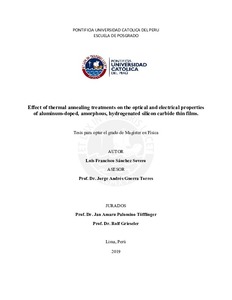| dc.contributor.advisor | Guerra Torres, Jorge Andrés | |
| dc.contributor.author | Sánchez Sovero, Luis Francisco | es_ES |
| dc.date.accessioned | 2019-07-04T17:46:00Z | es_ES |
| dc.date.available | 2019-07-04T17:46:00Z | es_ES |
| dc.date.created | 2019 | es_ES |
| dc.date.issued | 2019-07-04 | es_ES |
| dc.identifier.uri | http://hdl.handle.net/20.500.12404/14529 | |
| dc.description.abstract | In this work, a systematic study of the structural, optical and electrical properties of aluminum doped hydrogenated amorphous silicon carbide (Al-doped a-SiC:H) thin films grown by radio frequency magnetron sputtering is presented. The samples were grown using a high purity Al and SiC targets in a hydrogen-rich atmosphere and then were subjected to a rapid thermal annealing processes with temperatures of up to 600 °C. The film thickness ranged from 321 nm to 266 nm. The amorphous nature of the thin films was confirmed by X-ray diffraction measurements before and after the annealing treatments. Fourier transform infrared spectroscopy analysis revealed the different heteronuclear bonds present in the samples, whilst Raman spectroscopy showed the different homonuclear bonds present in the material. The evolution of the latter bonds with annealing temperature was assessed, showing a change in the structure of the thin film. Energy-dispersive X-Rays Spectroscopy confirmed the incorporation of aluminum in the amorphous silicon carbide matrix. UV-VIS Transmittance spectra revealed optical parameters such as Tauc energy bandgap, Iso-absorption energy bandgap and refractive index. Furthermore, the bandgap is also determined by means of a recently developed band-fluctuation model. In addition, electrical resistivity is determined by means of a four-probe Van Der Pauw method. Only the samples annealed at 600 °C exhibited contacts with an Ohmic behavior. The annealed films exhibited lower resistivities than the as-deposited ones, probably due to a thermal-induced reordering of the atoms. This reordering is shown in the variation of the Urbach energy which is related to an increase in the Si-C bond density, due to the dissociation of the hydrogen-related bonds. | es_ES |
| dc.description.abstract | En este trabajo de tesis se presenta el estudio las propiedades estructurales y optoelectrónicas de carburo de silicio amorfo hidrogenado dopado con aluminio fabricado mediante pulverización catódica de radio frecuencia. Las muestras se fabricaron usando target de SiC y Al de alta pureza en atmosfera de hidrogeno. Luego las películas fueron calentadas hasta la temperatura de 600°C en un horno de rápido procesamiento térmico. La difracción de rayos X confirma la naturaleza amorfa de las películas. Los espectros de absorción infrarroja muestran los diferentes enlaces hetero-nucleares mientras que la espectroscopia Raman nos muestra los diferentes enlaces hononucleares presentes en la muestra. Se evaluó la evolución de los últimos enlaces con el tratamiento térmico, mostrando un cambio en la estructura del material. Espectroscopía de dispersión de energía de rayos X nos muestra la incorporación de aluminio en la matriz de carburo de silicio amorfo. Los espectros de transmitancia UV-VIS revelan parámetros ópticos tales como energía de Tauc, energía de Iso- absorción, energía de Tauc e índice de refracción. Además, el modelo de fluctuación de bandas desarrollado recientemente nos permite determinar los bordes de movilidad y energía de Urbach. Adicionalmente, el método de Van Der Pauw nos permite determinar el valor de la resistividad eléctrica de la muestra, solo a 600°C, donde se obtuvo un comportamiento óhmico mostrando baja resistividad eléctrica, probablemente debido a un reordenamiento de los átomos inducidos térmicamente. Este reordenamiento estructural se muestra en la variación de la energía de Urbach que está asociada con el aumento de la densidad de enlaces Si-C, debido a la disociación de los enlaces relacionados con el hidrogeno. | es_ES |
| dc.language.iso | eng | es_ES |
| dc.publisher | Pontificia Universidad Católica del Perú | es_ES |
| dc.rights | info:eu-repo/semantics/openAccess | es_ES |
| dc.rights.uri | http://creativecommons.org/licenses/by-nc-sa/2.5/pe/ | * |
| dc.subject | Carburos--Propiedades electrónicas | es_ES |
| dc.subject | Materiales compuestos--Propiedades ópticas | es_ES |
| dc.subject | Materiales compuestos--Propiedades electrónicas | es_ES |
| dc.subject | Carburos--Propiedades ópticas | es_ES |
| dc.subject | Películas delgadas | es_ES |
| dc.title | Effect of thermal annealing treatments on the optical and electrical properties of aluminum-doped, amorphous, hydrogenated silicon carbide thin films | es_ES |
| dc.type | info:eu-repo/semantics/masterThesis | es_ES |
| thesis.degree.name | Maestro en Física | es_ES |
| thesis.degree.level | Maestría | es_ES |
| thesis.degree.grantor | Pontificia Universidad Católica del Perú. Escuela de Posgrado | es_ES |
| thesis.degree.discipline | Física | es_ES |
| renati.advisor.dni | 46163725 | |
| renati.discipline | 533017 | es_ES |
| renati.level | https://purl.org/pe-repo/renati/level#maestro | es_ES |
| renati.type | http://purl.org/pe-repo/renati/type#tesis | es_ES |
| dc.publisher.country | PE | es_ES |
| dc.subject.ocde | https://purl.org/pe-repo/ocde/ford#1.03.00 | es_ES |






